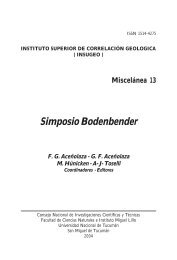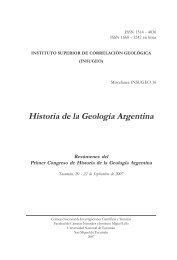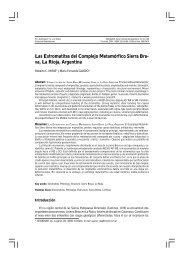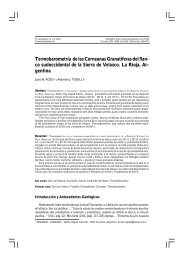123MODELO GEOFÍSICO DEL CONTACTO ORÓGENO PAMPEANO / CRATÓN DEL RÍO DE LA PLATAOmarini R. H. y Sureda R. 1993. Evolución geodinámica y configuración paleogeográfica <strong>en</strong> los Andes c<strong>en</strong>trales delproterozoico superior al Paleozoico inferior: modelos, alternativas y problemas. En 12º Congreso GeológicoArg<strong>en</strong>tino, Bu<strong>en</strong>os Aires., Arg<strong>en</strong>tina, 3: 291-307.Otam<strong>en</strong>di, J., Fagiano, M., Nullo, F. y Patiño Douce, E. 1998. Petrology, geochemistry and metamorphic conditions of teh AchirasComplex, southern Sierras de Comechingones. Revista de la Asociación Geológica Arg<strong>en</strong>tina, 53 (1), 27-40.Platt, J.P. 1993. Mechanics of oblique converge. Journal of Geophysical Researtch-Solid Earth, 98 (B9), 239-256.Ramé, G., Kraemer, P. y Introcaso, A. 1995. Evid<strong>en</strong>cia geofísica de un oróg<strong>en</strong>o colisional para el basam<strong>en</strong>to proterozoicode las Sierras de Córdoba, Arg<strong>en</strong>tina. I Congreso Latinoamericano de Geofísica Río’95, 2:1041-1044. Brasil.Ramé, G.A. y Miró, R.C. 2010. Estudio gravimétrico del borde occid<strong>en</strong>tal del Cratón Río de la Plata. 6º CongresoUruguayo de Geología. Actas <strong>en</strong> CD, trabajo 071: 6pp. Lavalleja, Uruguay.Ramos, V.A. 1988. Late Proterozoic-Early Paleozoic of South America: a collisional story. Episodes 11: 168-174.Ramos V. A. y Vujovich A. G. 1993. Laur<strong>en</strong>tia – Gondwana connection: a SouthAmerican perspective. GSA, Abstracts with Programs,Boston. Vol 1.Ramos, V.A., Vujovich, G., Martino, R., y Otam<strong>en</strong>di, J. 2010. Pampia: a large cratonic block missing in the Rodinia supercontinet.Journal of Geodynamics 50 (2010) 243–255.Rapela, C. W., Coira, B., Toselli, A. J., and Saaverdra, J., 1992. The Lower Paleozoic Magmatism of southwestern Gondwana and theevolution of the Famatinian orog<strong>en</strong>e. International Geology Review v. 34 (11):1081-1142.Rapela, C.W., Pankhurst, R.J., Casquet, C., Baldo, E., Saavedra, J. and Galindo, E. 1998. The Pampean orog<strong>en</strong>y of the southernproto-Andes evid<strong>en</strong>ce for Cambrian contin<strong>en</strong>tal collision in the Sierras de Córdoba, En: Pankhurst, R.J. y Rapela, C.W., (Eds.).The Proto-Andean Margin of the South America: Special Publication of the Geological Society 147, London.Rapela, C. W., 2000. The Sierras Pampeanas of Arg<strong>en</strong>tina: Paleozoic Building of the Southern Proto-Andes, in Cordani, U. G.; Milani,E. J.; Thomaz Filho, A., and Campos, D. A., eds., Tectonic Evolution of SouthAmerica, Rio de Janeiro, 31stInternational Geological Congress, p. 381-387.Rapela, C. W., Pankhurst, R.J., Casquet, C., Fanning, C.M., Baldo, E.G., Gonzalez Casado, J.M. and Dahlkist, J. 2007. TheRío de la Palta craton and the assembly of SW Gondwana. Earth Sci<strong>en</strong>ce Reviews 83(1-2):49-82.Regnier M., Chiu, J., Smalley, R., Isacks, B. & Araujo, M, 1994. Crustal thickness variation in the Andean foreland, Arg<strong>en</strong>tina, fromconverted waves. Bulletin of the Seismological Society of America, 84, (4) : 1097-1111.Russo, A., Ferello, R. y Chebli, G. 1979. Llanura Chaco Pampeana. Segundo Simposio de Geología Regional Arg<strong>en</strong>tina,vol. I: 139-183. Córdoba. Arg<strong>en</strong>tina.Schwartz, J. J., Gromet, L.P. and Miró, R.C. 2008. Timing and duration of the Calc Alkaline Arc of the Pampean Aorog<strong>en</strong>y:Implications for the late Neoproterozoic to Cambrian evolution of Western Gondwana. The Journal of Geology, vol.116: 39-61.USA.SEGEMAR, 1996. Relevami<strong>en</strong>tos aeromagnéticos del conv<strong>en</strong>io AGSO. Versión digital inédita.Simpson, C., Law, R. D., Gromet, L. P., Miró, R.C., and Northrup, C. J. 2003. Paleozoic deformation in the Sierras de Cordobaand Sierra de Las Minas, eastern Sierras Pampeanas, Arg<strong>en</strong>tina. Journal of SouthAmerican Earth Sci<strong>en</strong>ces v. 15:749-764.Sims, J. P., Skirrow, R., Stuart-Smith, P.G. and Lyons. P. 1997. Report on Geology and Metallog<strong>en</strong>y of the Sierras de San Luis andComechingones, mapa 1:250.000, provincias de San Luis y Córdoba. Geosci<strong>en</strong>tific mapping of The Sierras Pampeanas. Arg<strong>en</strong>tine –Australia Cooperative Projnect. Anales 28, SEGEMAR. Bu<strong>en</strong>os Aires.Sims, J., Ireland, T. R., Camacho, A., Lyos, P., Pieters, P. E., Skirrow, R., Stuart-Smith, P. G., and Miró, R. C. 1998. U-Pb,Th-Pb, and Ar-Ar geochronology from the Southern Sierras Pampeanas, Arg<strong>en</strong>tina: implications for the Paleozoic tectonic evolutionof the western Gondwana margin, in Pankhurst, R. J., and Rapela, C. W., eds., The Proto-Andean Margin of Gondwana,Geological Society of London Special Publication, p. 259-281.Thomas, M.D. 1983. Tectonic significance of paired gravity anomalies in the southern and C<strong>en</strong>tral Appalachians; in Hatcher & Williams,1983. Contributios to the Tectonics and Geophysics of Mountain Chains. Geological Society of American, Memoir 158.Von Gos<strong>en</strong>, W. and Prozzi, C. 2005. Deformation of an Early Paleozoic magmatic arc related to terrane collision: the Sierra de San Luis(Eastern Sierras Pampeanas, Arg<strong>en</strong>tina). Neues Jbch. für Geologie und Pälaontologie Ab. 238(1): 107-160.Whitmeyer, S. J., and Simpson, C., 2003. High strain-rate deformation fabrics characterize a kilometer thick Paleozoic fault zone in theEastern Sierras Pampeanas, c<strong>en</strong>tral Arg<strong>en</strong>tina. Journal of Structural Geology v. 25:909-922.Willner, 1990. División tectonometamórfica del basam<strong>en</strong>to del noroeste Arg<strong>en</strong>tino. En: Aceñolaza, F.G., Miller, H. yToselli, A.J. (Eds.): El Ciclo Pampeano <strong>en</strong> el Noroeste Arg<strong>en</strong>tino, pp.113-159. Serie Correlación Geológica 4,Tucumán.Woollard, G. 1969. The relation of gravity anomalies to surface elevation, crustal structure and geology. University of Wisconsin,Geophysical Polar Research C<strong>en</strong>ter. Report 62-9, 292 p.Recibido: 22 de julio de 2011Aceptado: 1 de octubre de 2011
Serie Correlación Geológica, 27 (2): 125-136Temas de Correlación Geológica II(1) Tucumán, 2011 – ISSN 1514-4186 – ISSN on-line 1666-9479Sand Characteristics and Beach Profiles of the Coast ofGaza Strip, Palestine.Khalid Fathi UBEID 1Abstract: SAND CHARACTERISTICS AND BEACH PROFILES OF THE COAST OF GAZA STRIP, PALESTINE.- The Gaza Strip’scoastline forms a small section of the south-eastern corner of the Levantine Basin. The Strip is 45 km long and from 6 to12 km wide. Its coastal zone covers approximately 74 km 2 , of which 2.7 km 2 is beach. This study first describes the coastalzone’s profile from observations and the literature. This study also collected 36 sandy sedim<strong>en</strong>t samples from 12 sitesalong its beaches and performed a textural study and statistical analysis of grain-size distribution. The beach t<strong>en</strong>ds to b<strong>en</strong>arrower in the north and c<strong>en</strong>ter and wider in the south and its northernmost stretches and in some sites in the c<strong>en</strong>ter. Th<strong>en</strong>arrower stretches t<strong>en</strong>d to be due to the effects of the seaport and other human construction activity on the sedim<strong>en</strong>tationand erosion rates. The beach profile’s slope varies from a few degrees to 90 degrees. At some sites actions of the wavesand tides have caused the sea cliff to erode and mix with the beach sands. Longshore curr<strong>en</strong>ts bring sands to the beachesfrom the Nile delta and th<strong>en</strong> northward along the shore. The sand grains become segregated as they move from south tonorth, being finer as they move north. In g<strong>en</strong>eral, this study’s analysis of the surface samples found medium-grained sandsto predominate, and the sands at most beach sites to be moderately well sorted, mainly as a result of the actions of marinecurr<strong>en</strong>ts; waves, and tides.Keywords: Sand, Textural Parameters, Longshore Sedim<strong>en</strong>t Transport, Mediterranean Coast, Gaza Beaches.IntroductionSedim<strong>en</strong>tologists t<strong>en</strong>d to use grain-size distribution to elucidate transport dynamics. Suchdiverse factors as waves, winds, longshore curr<strong>en</strong>ts, and beach relief control littoral sedim<strong>en</strong>ts’textural composition (Folk, 1974; Komar, 1976; Ibbek<strong>en</strong> and Schleyer, 1991; Caranza-Edwards,2001; Kasper-Zubillaga and Carranza-Edwards, 2005; Caranza-Edwards et al., 2009). Coastsformed by non-consolidated sedim<strong>en</strong>ts constitute approximately 40% of the world’s sand andgravel beaches (Bird, 2000). Beaches are exposed to such marine, fluvial, and eolian processes aswaves and tidal regimes, fluvial discharges, and wind transport, factors that control sand beaches’grain size and relief (Le Pera and Critelli, 1997).Palestine’s coastline is broadly concave, tr<strong>en</strong>ding g<strong>en</strong>erally NNE-to-SSW. Figure 1Aillustrates this. It lies betwe<strong>en</strong> two parallel lineam<strong>en</strong>ts; the eastern, or onshore, lineam<strong>en</strong>t is anescarpm<strong>en</strong>t that is locally steeper than 45 degrees and rises as high as 50 m above mean sea level(MSL) (Neev et al., 1987). A sequ<strong>en</strong>ce of late Pleistoc<strong>en</strong>e to Holoc<strong>en</strong>e sedim<strong>en</strong>ts crops out alongthe cliff. The top of this sequ<strong>en</strong>ce ext<strong>en</strong>ds eastward to form Palestine’s now-elevated alluvialcoastal plain. The western, or offshore, lineam<strong>en</strong>t is a low submarine escarpm<strong>en</strong>t. It forms thewestern limit of a patchy abraded terrace that is a few hundred meters wide.The coastal plain adjoins the coastline on the land and the contin<strong>en</strong>tal shelf b<strong>en</strong>eath theocean. Both areas contain broadly curved subparallel sand ridges that are similar to each other.River valleys and ridge bifurcations provide smaller interruptions. The ridges necessarily arefarther apart at the southwest and converge toward the north because the combined coastal plainand shelf narrows to the north, yet has relatively smooth slopes toward an approximately uniform1Departm<strong>en</strong>t of Geology, Faculty of Sci<strong>en</strong>ce, Al Azhar University – GazaP.O. Box 1277, Gaza, PalestineE-mail: k.ubeid@alazhar.edu.ps


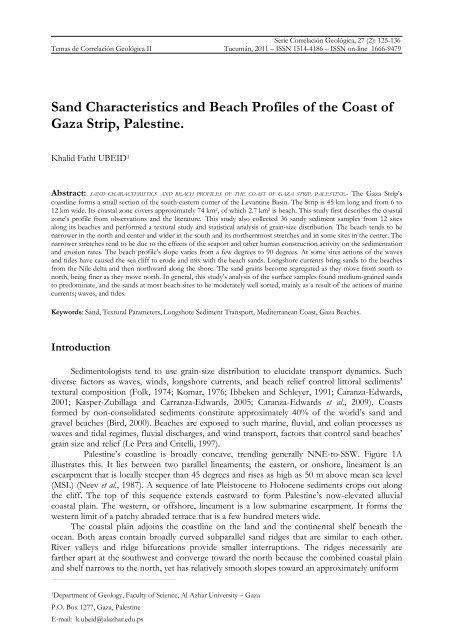
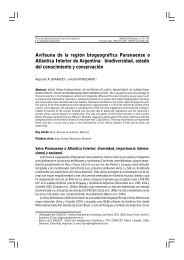

![Descargar El Libro Completo [5.631 Kb] - INSUGEO](https://img.yumpu.com/40710231/1/177x260/descargar-el-libro-completo-5631-kb-insugeo.jpg?quality=85)

